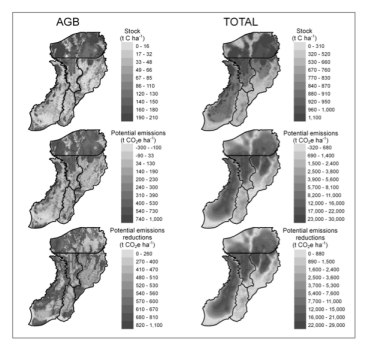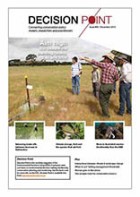 Ecosystem services are the direct and indirect benefits that people derive from ecosystems including the production of goods (e.g. food, water, raw materials), process that support and regulate life (e.g. regulation of water flows, climate regulation, moderation of extreme events, carbon sequestration) and cultural connections that enhance human experience (e.g. scenic beauty, recreation, cultural heritage). We are increasingly aware of how vital these services are to human wellbeing globally, and the urgent need to prevent their loss or degradation.
Ecosystem services are the direct and indirect benefits that people derive from ecosystems including the production of goods (e.g. food, water, raw materials), process that support and regulate life (e.g. regulation of water flows, climate regulation, moderation of extreme events, carbon sequestration) and cultural connections that enhance human experience (e.g. scenic beauty, recreation, cultural heritage). We are increasingly aware of how vital these services are to human wellbeing globally, and the urgent need to prevent their loss or degradation.
Our research looks at how we can quantify ecosystem services and their relationships with biodiversity, and how we can incorporate the value of ecosystem services into decision-making and landscape planning. This is precisely the kind of research that will be fundamental for the new Intergovernmental Panel on Biodiversity and Ecosystem Services (IPBES), which will place biodiversity and ecosystem services at the forefront of national and global policy.
The types of questions we ask:
Understanding and mapping ecosystem services
- How can we model and map the flows of ecosystem services, as the full set of processes from ecosystem sources to human beneficiaries?
- What are the trade-offs or interactions among different ecosystem services?
- What are the consequences of drivers of change (e.g. climate change and land use change) for ecosystem services and biodiversity?
- How effective are management actions in conserving or restoring ecosystem services?
- Are we using the growing body of ecosystem services research to make decisions?
Landscape planning for multiple objectives
- How can we integrate ecosystem services into decision-making, and handle the complexity of ecosystem service flows in space and time?
- What are the synergies or trade-offs between ecosystem services and biodiversity conservation?
- How can landscape planning optimise objectives for ecosystem services, biodiversity, and equitable development?

Ecosystem Services markets
With the rapid growth and interest in carbon markets (and other ecosystem service financial incentives), we are exploring the benefits and also the potential for perverse outcomes from such investments. In particular, we are interested in answering questions such as:
- How can biodiversity considerations best be integrated into markets for ecosystem services, to maximise benefits and minimise possible harms?
- How we can best evaluate (the mostly) shorter-term commercial interests in ecosystem service markets against longer-term objectives, or opportunities that are forgone?
Read these stories in Decision Point magazine…
 Balancing trade-offs between land-use policy objectives
Balancing trade-offs between land-use policy objectives
Conservation and economic paradigms are shifting. In decades past it seemed fine to dedicate land to either conservation or production. But more recently we realise that this is inadequate to save all biodiversity, particularly where we want and need it. We live in a world of complexity and competing objectives: multiple stakeholders, multiple uses of the same land and multiple goals (effectiveness, efficiency and equity). Given this complexity, why, where, and how do we best conserve nature?
We’ve been working on a few different ways to understand how policy… read more
 Making more of the concept of ecosystem services
Making more of the concept of ecosystem services
Ecosystem services are the benefits people obtain from ecosystems. In recent years they have become an important concept in science and policy arenas. This is reflected in a substantial growth in scientific research and widespread calls for integrating ecosystem services into management decisions. But how much of a contribution are assessments of ecosystem services actually making? We reviewed the scientific literature (Figure 1) and found that ecosystem service assessments are not covering all elements of the decision-making process. The assessments we reviewed were particularly poor at involving stakeholders in setting objectives and developing user-related measures… read more
Linked themes
Conservation and development in production landscapes
Other links
Diversitas, IPBES, Natural Capital Project, TEEB – The Economics of Ecosystems and Biodiversity , Ecosystem Services Partnership
Key references
Matzek, V., Wilson, K.A. and Kragt, M. 2019. Mainstreaming of ecosystem services as a rationale for ecological restoration in Australia. Ecosystem Services. 35:79-86. https://doi.org/10.1016/j.ecoser.2018.11.005
Davis, K.J., Binner, A., Bell, A., Day, B., Poate, T., Rees, S., Smith, G., Wilson, K. and Bateman, I. 2019. A generalisable integrated natural capital methodology for targeting investment in coastal defence. Journal of Environmental Economics and Policy. 8(4): 429-446. https://doi.org/10.1080/21606544.2018.1537197
Budiharta, S., Meijaard, E., Gaveau, D.L.A., Struebig, M. J., Wilting, A., Kramer-Schadt, S., Niedballa, J., Raes, N., Maron, M. and Wilson, K.A. 2018. Restoration to offset the impacts of developments at a landscape scale reveals opportunities, challenges and tough choices. Global Environmental Change. 52:152-161 https://doi.org/10.1016/j.gloenvcha.2018.07.008
Martinez-Harms, M. J., Bryan, B. A., Wood, S.A., Fisher, D.M., Law, E., Rhodes, J., Dobbs, C., Biggs, D. and Wilson, K.A. 2018. Inequality in access to cultural ecosystem services from protected areas in the Chilean biodiversity hotspot. Science of the Total Environment. 636(15): 1128-1138 https://doi.org/10.1016/j.scitotenv.2018.04.353
Law E.A., Bryan B.A., Meijaard E., Mallawaarachchi T., Struebig M.J., Watts M. and Wilson K.A. 2017. Mixed policies give more options in multifunctional tropical forest landscapes. Journal of Applied Ecology. 54(1): 51-60. http://dx.doi.org/10.1111/1365-2664.12666
Wells, J., Wilson, KA., Abram, N., Nunn, M., Gaveau, D., Runting, R,. Tarniati, N., Mengersen, K., Meijaard, E. 2016. Rising floodwaters: Mapping impacts and perceptions of flooding in Indonesian Borneo. Environmental Research Letters. 11: 064016 http://dx.doi.org/10.1088/1748-9326/11/6/064016
Kragt M.E., Gibson, F.L., Maseyk, F., and Wilson, K.A. 2016. Public willingness to pay for carbon farming and its co-benefits. Ecological Economics. 126: 125-131. http://dx.doi.org/10.1016/j.ecolecon.2016.02.018
Wilson, K.A. and Law, E.L. 2015. How to avoid underselling biodiversity with ecosystem services. Trends in Ecology and Evolution. 30(11): 641-648. http://dx.doi.org/10.1016/j.tree.2016.03.002
Law EA, Bryan BA, Meijaard E, Mallawarachchi T, Struebig M, Wilson KA (2015) Ecosystem services from a degraded peatland of Central Kalimantan: implications for policy, planning, and management. Ecological Applications. 25, 70-87, http://dx.doi.org/10.1890/13-2014.1
Budiharta, S., Slik, F., Raes, N., Meijaard, E., Erskine, P. and Wilson. K.A. 2014. Estimating the Aboveground Biomass of Bornean Forest. Biotropica. 46, 5: 507-511. http://dx.doi.org/10.1111/btp.12132
Martinez-Harms, M. J., B. A. Bryan, P. Balvanera, E. A. Law, J. R. Rhodes, H. P. Possingham, and K. A. Wilson. 2015. Making decisions for managing ecosystem services. Biological Conservation. 184: 229-238. http://dx.doi.org/10.1016/j.biocon.2015.01.024
Broch, S.W., Strange, N., Jacobsen, J.B. and Wilson, K.A. 2013. Farmers’ willingness to provide ecosystem services and effects of their spatial distribution. Ecological Economics 92: 78-86. http://dx.doi.org/10.1016/j.ecolecon.2011.12.017
You must be logged in to post a comment.